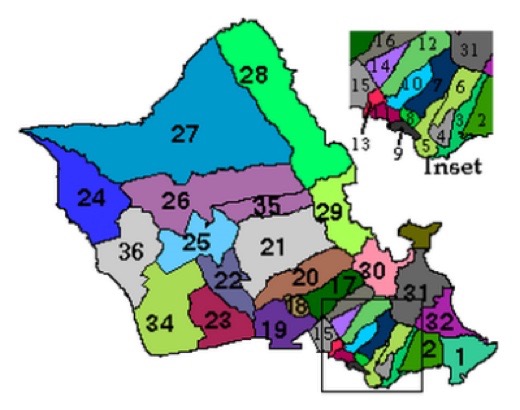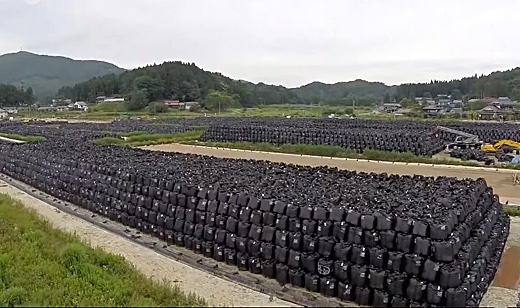SUBHEAD: People in the new town square i.e. the Walmart, are prematurely old, fattened and sickened.
By James Kunstler on 28 April 2017 for Kunstler.com -
(http://kunstler.com/clusterfuck-nation/the-national-blues/)

Image above: Walmart electric shopping carts lined up with the old, fat and sick. From (http://acidcow.com/pics/74507-walmart-shoppers-are-a-special-breed-of-people-27-pics.html).
While the news waves groan with stories about “America’s Opioid Epidemic” you may discern that there is little effort to actually understand what’s behind it, namely, the fact that life in the United States has become unspeakably depressing, empty, and purposeless for a large class of citizens.
I mean unspeakably literally. If you want evidence of our inability to construct a coherent story about what’s happening in this country, there it is.
I live in a corner of Flyover Red America where you can easily read these conditions on the landscape — the vacant Main Streets, especially after dark, the houses uncared for and decrepitating year by year, the derelict farms with barns falling down, harvesters rusting in the rain, and pastures overgrown with sumacs, the parasitical national chain stores like tumors at the edge of every town.
You can read it in the bodies of the people in the new town square, i.e. the Walmart: people prematurely old, fattened and sickened by bad food made to look and taste irresistible to con those sunk in despair, a deadly consolation for lives otherwise filled by empty hours, trash television, addictive computer games, and their own family melodramas concocted to give some narrative meaning to lives otherwise bereft of event or effort.
These are people who have suffered their economic and social roles in life to be stolen from them.
They do not work at things that matter. They have no prospects for a better life — and, anyway, the sheer notion of that has been reduced to absurd fantasies of Kardashian luxury, i.e. maximum comfort with no purpose other than to enable self-dramatization.
And nothing dramatizes a desperate life like a drug habit. It concentrates the mind, as Samuel Johnson once remarked, like waiting to be hanged.
On display in the news reports about the mystery of the opioid epidemic is America’s neurotic reliance on supposedly scientific “studies.”
Never before in history has a society studied so much and learned so little — which is what happens when you resort to scientizing things that are essentially matters of conduct. It rests on the fallacy that if you compile enough statistics about something, you can control it.
Opioid addiction is just another racket, a personal one, in a culture of racketeering that is edging toward truly epochal failure, for the simple reason that rackets are dishonest, and pervasive dishonesty is at odds with reality, and reality always has the final say.
The eerie thing about reading the landscape of despair is that you can see the ghosts of purpose and meaning in it.
Before 1970, there were at least five factories in my little town, all designed originally to run on the water power (or hydro-electric) of the Battenkill River, a tributary of the nearby Hudson.
The ruins of these enterprises are still there, the red brick walls with the roofs caved in, the twisted chain-link fence that no longer has anything to protect, the broken masonry mill-races.
The ghosts of commerce are also plainly visible in the bones of Main Street. These were businesses owned by people who lived in town, who employed other people who lived in town, who often bought and sold things grown or made in and around town.
Every level of this activity occupied people and gave purpose and meaning to their lives, even if the work associated with it was sometimes hard. Altogether, it formed a rich network of interdependence, of networked human lives and family histories.
What galls me is how casually the country accepts the forces that it has enabled to wreck these relationships. None of the news reports or “studies” done about opioid addiction will challenge or even mention the deadly logic of Walmart and operations like it that systematically destroyed local retail economies (and the lives entailed in them.)
The news media would have you believe that we still value “bargain shopping” above all other social dynamics. In the end, we don’t know what we’re talking about.
I’ve maintained for many years that it will probably require the collapse of the current arrangements for the nation to reacquire a reality-based sense of purpose and meaning. I’m kind of glad to see national chain retail failing, one less major bad thing in American life.
Trump was just a crude symptom of the sore-beset public’s longing for a new disposition of things. He’ll be swept away in the collapse of the rackets, including the real estate racket that he built his career on.
Once the collapse gets underway in earnest, starting with the most toxic racket of all, contemporary finance, there will be a lot to do.
The day may dawn in America when people are too busy to resort to opioids, and actually derive some satisfaction from the busy-ness that occupies them.
.
By James Kunstler on 28 April 2017 for Kunstler.com -
(http://kunstler.com/clusterfuck-nation/the-national-blues/)

Image above: Walmart electric shopping carts lined up with the old, fat and sick. From (http://acidcow.com/pics/74507-walmart-shoppers-are-a-special-breed-of-people-27-pics.html).
While the news waves groan with stories about “America’s Opioid Epidemic” you may discern that there is little effort to actually understand what’s behind it, namely, the fact that life in the United States has become unspeakably depressing, empty, and purposeless for a large class of citizens.
I mean unspeakably literally. If you want evidence of our inability to construct a coherent story about what’s happening in this country, there it is.
I live in a corner of Flyover Red America where you can easily read these conditions on the landscape — the vacant Main Streets, especially after dark, the houses uncared for and decrepitating year by year, the derelict farms with barns falling down, harvesters rusting in the rain, and pastures overgrown with sumacs, the parasitical national chain stores like tumors at the edge of every town.
You can read it in the bodies of the people in the new town square, i.e. the Walmart: people prematurely old, fattened and sickened by bad food made to look and taste irresistible to con those sunk in despair, a deadly consolation for lives otherwise filled by empty hours, trash television, addictive computer games, and their own family melodramas concocted to give some narrative meaning to lives otherwise bereft of event or effort.
These are people who have suffered their economic and social roles in life to be stolen from them.
They do not work at things that matter. They have no prospects for a better life — and, anyway, the sheer notion of that has been reduced to absurd fantasies of Kardashian luxury, i.e. maximum comfort with no purpose other than to enable self-dramatization.
And nothing dramatizes a desperate life like a drug habit. It concentrates the mind, as Samuel Johnson once remarked, like waiting to be hanged.
On display in the news reports about the mystery of the opioid epidemic is America’s neurotic reliance on supposedly scientific “studies.”
Never before in history has a society studied so much and learned so little — which is what happens when you resort to scientizing things that are essentially matters of conduct. It rests on the fallacy that if you compile enough statistics about something, you can control it.
Opioid addiction is just another racket, a personal one, in a culture of racketeering that is edging toward truly epochal failure, for the simple reason that rackets are dishonest, and pervasive dishonesty is at odds with reality, and reality always has the final say.
The eerie thing about reading the landscape of despair is that you can see the ghosts of purpose and meaning in it.
Before 1970, there were at least five factories in my little town, all designed originally to run on the water power (or hydro-electric) of the Battenkill River, a tributary of the nearby Hudson.
The ruins of these enterprises are still there, the red brick walls with the roofs caved in, the twisted chain-link fence that no longer has anything to protect, the broken masonry mill-races.
The ghosts of commerce are also plainly visible in the bones of Main Street. These were businesses owned by people who lived in town, who employed other people who lived in town, who often bought and sold things grown or made in and around town.
Every level of this activity occupied people and gave purpose and meaning to their lives, even if the work associated with it was sometimes hard. Altogether, it formed a rich network of interdependence, of networked human lives and family histories.
What galls me is how casually the country accepts the forces that it has enabled to wreck these relationships. None of the news reports or “studies” done about opioid addiction will challenge or even mention the deadly logic of Walmart and operations like it that systematically destroyed local retail economies (and the lives entailed in them.)
The news media would have you believe that we still value “bargain shopping” above all other social dynamics. In the end, we don’t know what we’re talking about.
I’ve maintained for many years that it will probably require the collapse of the current arrangements for the nation to reacquire a reality-based sense of purpose and meaning. I’m kind of glad to see national chain retail failing, one less major bad thing in American life.
Trump was just a crude symptom of the sore-beset public’s longing for a new disposition of things. He’ll be swept away in the collapse of the rackets, including the real estate racket that he built his career on.
Once the collapse gets underway in earnest, starting with the most toxic racket of all, contemporary finance, there will be a lot to do.
The day may dawn in America when people are too busy to resort to opioids, and actually derive some satisfaction from the busy-ness that occupies them.
.











